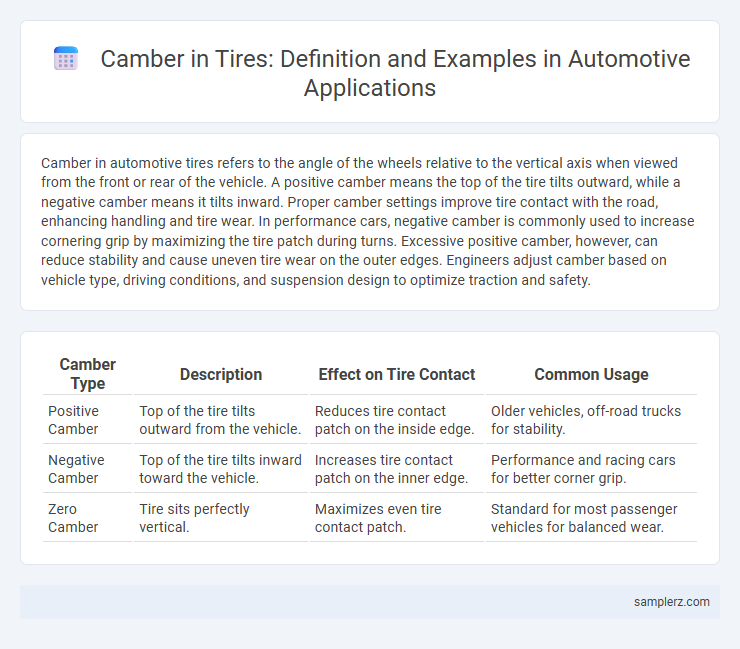Camber in automotive tires refers to the angle of the wheels relative to the vertical axis when viewed from the front or rear of the vehicle. A positive camber means the top of the tire tilts outward, while a negative camber means it tilts inward. Proper camber settings improve tire contact with the road, enhancing handling and tire wear. In performance cars, negative camber is commonly used to increase cornering grip by maximizing the tire patch during turns. Excessive positive camber, however, can reduce stability and cause uneven tire wear on the outer edges. Engineers adjust camber based on vehicle type, driving conditions, and suspension design to optimize traction and safety.
Table of Comparison
| Camber Type | Description | Effect on Tire Contact | Common Usage |
|---|---|---|---|
| Positive Camber | Top of the tire tilts outward from the vehicle. | Reduces tire contact patch on the inside edge. | Older vehicles, off-road trucks for stability. |
| Negative Camber | Top of the tire tilts inward toward the vehicle. | Increases tire contact patch on the inner edge. | Performance and racing cars for better corner grip. |
| Zero Camber | Tire sits perfectly vertical. | Maximizes even tire contact patch. | Standard for most passenger vehicles for balanced wear. |
Understanding Camber in Automotive Tires
Camber in automotive tires refers to the angle of the wheels relative to the vertical axis when viewed from the front or rear of the vehicle, typically measured in degrees. Negative camber occurs when the top of the tire tilts inward, enhancing cornering performance by increasing the tire's contact patch during turns. Excessive camber can lead to uneven tire wear, reducing overall tire lifespan and affecting vehicle stability.
Positive vs. Negative Camber: Key Differences
Positive camber occurs when the top of the tire tilts outward, improving stability during straight-line driving and reducing steering effort. Negative camber features the top of the tire tilting inward, enhancing cornering grip by increasing the tire's contact patch with the road surface. Understanding the differences between positive and negative camber is essential for optimizing tire wear, handling performance, and vehicle dynamics in automotive applications.
Real-World Examples of Camber in Tires
Negative camber is commonly seen in performance cars like the Nissan 370Z, where the top of the tire tilts inward to improve cornering grip and stability. Racing vehicles such as Formula 1 cars utilize extreme camber angles to maximize tire contact patch during high-speed turns, enhancing traction and reducing lap times. Everyday vehicles like the Honda Civic may have slight positive camber to promote tire wear balance and improve straight-line stability on uneven roads.
How Camber Angle Affects Tire Performance
Camber angle, the tilt of a tire relative to the vertical axis, directly influences tire contact patch and grip during cornering. Negative camber improves traction by increasing the tire's contact area in turns, enhancing handling and reducing understeer. Excessive camber causes uneven tire wear and decreased straight-line stability, impacting overall tire performance.
Camber in Racing Cars: Practical Applications
Camber in racing cars is optimized to enhance tire contact during high-speed cornering, where negative camber angles between -2 to -4 degrees improve grip and stability by maximizing the tire's contact patch. Adjusting camber helps balance tire wear and handling precision, crucial for maintaining consistent lap times on varying track surfaces. Racing engineers often fine-tune camber settings to adapt to specific track conditions, emphasizing performance and vehicle control under extreme lateral loads.
Camber Adjustment in Off-Road Vehicles
Camber adjustment in off-road vehicles plays a critical role in optimizing tire contact with uneven terrain, enhancing traction and stability during rugged driving conditions. Negative camber angles are often increased to improve cornering performance on loose surfaces, reducing tire wear and preventing uneven tread degradation. Precision camber tuning ensures that off-road tires maintain maximum grip and durability by compensating for suspension articulation and chassis flex.
Impact of Camber on Tire Wear Patterns
Excessive negative camber causes uneven tire wear, primarily on the inner edges, reducing tire lifespan significantly. Positive camber leads to outer edge wear, compromising traction and handling stability. Optimal camber settings enhance tire contact with the road, promoting even wear and improving vehicle performance.
Factory Camber Settings in Popular Car Models
Factory camber settings in popular car models typically range from -0.5 to -1.5 degrees to optimize tire contact and handling performance. For instance, the Honda Civic often comes with a slight negative camber of around -0.7 degrees to enhance cornering stability, while the BMW 3 Series features a more aggressive factory camber near -1.2 degrees for improved grip during high-speed maneuvers. These calibrated settings play a critical role in balancing tire wear and vehicle dynamics in daily driving conditions.
Camber and Vehicle Handling: Case Studies
Positive camber, where the top of the tire tilts outward, often leads to reduced cornering grip but improved straight-line stability, as demonstrated in heavy-duty trucks designed for load balance. Negative camber, with the tire tilting inward at the top, enhances tire contact during cornering, improving handling performance in sports cars like the Subaru WRX and BMW M3. Case studies reveal that optimal camber settings are critical in racing vehicles to maximize traction and responsiveness while minimizing tire wear.
Best Practices for Camber Alignment in Tires
Optimal camber alignment enhances tire grip and extends tread life by maintaining even contact with the road surface. Best practices include measuring camber angles with precision tools like alignment machines to ensure specifications set by manufacturers, typically ranging from -0.5 to -1.5 degrees for performance vehicles. Regular inspections and adjustments prevent uneven tire wear, improve handling, and promote vehicle stability, especially during cornering.

example of camber in tire Infographic
 samplerz.com
samplerz.com